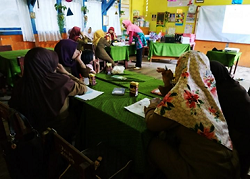Workshop Guru SDN Melayu 7 Banjarmasin dalam Menyusun Soal Cerita Berbasis Kearifan Lokal untuk Meningkatkan Kemampuan Berpikir Kreatif
Workshop for SDN Melayu 7 Banjarmasin Teachers in Developing Local Wisdom-Based Story Questions to Improve Creative Thinking Ability
DOI:
https://doi.org/10.33084/pengabdianmu.v5i1.971Keywords:
Creative thinking, Local culture, Problem StoryAbstract
SDN Melayu 7 is located in Banjarmasin Tengah and has implemented the 2013 curriculum. There are some problems found from interviews with the principal and some teachers, namely students, are more faced with routine questions and are required to be able to solve problems in the story of the question. While the teacher has difficulty making story questions that are easily understood by students. This activity aims to prepare teachers to know how to arrange story problems based on local wisdom in South Kalimantan to improve creative thinking skills. The approach used is active participant learning. The activity is divided into two stages, and stage I is focused on the question of story problems based on local wisdom in South Kalimantan, while in stage II, it is focused on the question of story problems based on local wisdom that can improve the ability to think creatively. To measure the success of each stage, an understanding questionnaire was given, and the work of the participant groups were seen. The activity is said to be successful if the average questionnaire comprehension is at least 75%. The results of the activity showed the level of understanding of the participants reached 93.61% in stage I and 91.94% in stage II. Also seen from the results of group work it can be concluded that participants can understand well the explanations given by the speakers.
Downloads
References
Budiarti, I., Agustina, W. 2017. Pengembangan perangkat pembelajaran pendidikan matematika realistik (PMR) berbasis ethnomathematics sebagai upaya mengembangkan kreativitas siswa. Math Didactic: Jurnal Pendidikan Matematika. 3(3):178-187. https://doi.org/10.33654/math.v3i3.70
Ekowati, D.W., Kusumaningtyas, D.I., Sulistyani, N. 2017. Ethnomathematica Dalam Pembelajaran Matematika (Pembelajaran Bilangan Dengan Media Batik Madura, Tari Khas Trenggal Dan Tari Khas Madura). JP2SD (Jurnal Pemikiran dan Pengembangan Sekolah Dasar). 5(2):716-721. https://doi.org/10.22219/jp2sd.v5i2.4820
Insani, M.D. 2016. Studi Pendahuluan Identifikasi Kesulitan Dalam Pembelajaran Pada Guru IPA SMP Se-Kota Malang. Jurnal Pendidikan Biologi. 7(2):81-93. http://dx.doi.org/10.17977/jpb.v7i2.723
Manizar, E. 2015. Peran Guru Sebagai Motivator Dalam Belajar. Tadrib: Jurnal Pendidikan Agama Islam. 1(2):204-222.
McComas, W.F. 2014. Trends in International Mathematics and Science Study (TIMSS). In: McComas W.F. (eds) The Language of Science Education. Rotterdam: SensePublishers. https://doi.org/10.1007/978-94-6209-497-0_97
Mulyati, T. 2011. Kemampuan Pemecahan Masalah Matematis Siswa Sekolah Dasar. 3(2):1-15. https://doi.org/10.17509/eh.v3i2.2807
Mustikasari, Zulkardi, Aisyah, N. 2010. Pengembangan Soal-Soal Open-Ended Pokok Bahasan Bilangan Pecahan Di Sekolah Menengah Pertama. Jurnal Pendidikan Matematika. 4(2):45-60. https://doi.org/10.22342/jpm.4.2.820.
Noor, F., Agustina, W. 2016. Hasil Belajar Matematika dan Tingkat Berpikir Kreatif Siswa SMP dalam Pembelajaran Berbasis Masalah yang Terintegrasi Pendekatan Saintifik. Math Didactic: Jurnal Pendidikan Matematika. 2(3):171-180. https://doi.org/10.33654/math.v2i3.46
Pemerintah Provinsi Kalimantan Selatan. 2016. Rencana Strategis Dinas Pendapatan Daerah Provinsi Kalimantan Selatan Tahun 2016-2021. Banjarmasin: Pemerintah Provinsi Kalimantan Selatan.
Pemerintah Republik Indonesia. 2010. Peraturan Pemerintah Nomor 17 Tahun 2010 Tentang Pengelolaan dan Penyelenggaraan Pendidikan.
Polya, G. 1973. How to Solve It: A New Aspect Mathematical Method. New Jersey: Princeton University Press.
Rafiah, H., Ekawati, A. 2017. Misconceptions of the Students with High Mathematical Creative Thinking Level in Solving the Geometric Shapes Problems. In Pasani, C.F., Winarti, A., Wati, M., Mu’in, F. (Eds.) Proceedings of the 5th SEA-DR (South East Asia Development Research) International Conference 2017 (SEADRIC 2017). 100:155-159. https://dx.doi.org/10.2991/seadric-17.2017.33
Rahmawati, A. 2019. Analisis Kesulitan Siswa Dalam Menyelesaikan Soal Cerita Matematika Berbasis Pembelajaran Pemecahan Masalah Kelas V SD Negeri Gebangsari 03. Jurnal Pengembangan Pembelajaran Matematika (JPPM). 1(2):46-51.
Rasyid, M.R. 2008. Optimalisasi Peran Guru Dalam Proses Transformasi Pengetahuan Dengan Menggunakan Media Pembelajaran. Lentera Pendidikan: Jurnal Ilmu Tarbiyah dan Keguruan. 11(1):55-68. https://doi.org/10.24252/lp.2008v11n1a5
Sa’djiah, C., Rafiah, H., Gipayana, M., Qohar, A., Anwar, L. 2016. Asesmen Pemecahan Masalah Open-Ended Untuk Mengukur Profil Berpikir Kreatif Matematis Siswa Berdasar Gender. Sekolah Dasar: Kajian Teori dan Praktik Pendidikan. 25(2):147-159. http://dx.doi.org/10.17977/um009v25i22016p147
Siswono, T.Y.E. 2005. Upaya meningkatkan kemampuan berpikir kreatif siswa melalui pengajuan masalah. Jurnal Pendidikan Matematika dan Sains. 10(1):1-9.

Downloads
Published
How to Cite
Issue
Section
License
Authors who publish with this journal agree to the following terms:
- Any article on the copyright is retained by the author(s).
- Author grant the journal, right of first publication with the work simultaneously licensed under a Creative Commons Attribution License that allows others to share work with acknowledgment of the work authors and initial publications in this journal.
- Authors are able to enter into a separate, additional contractual arrangements for non-exclusive distribution of published articles of work (eg, post-institutional repository) or publish it in a book, with acknowledgment of its initial publication in this journal.
- Authors are permitted and encouraged to post their work online (e.g., in institutional repositories or on their websites) prior to and during the submission process, as can lead to productive exchanges, as well as earlier and greater citation of published work.
- The article and any associated published material is distributed under the Creative Commons Attribution-ShareAlike 4.0 International License










